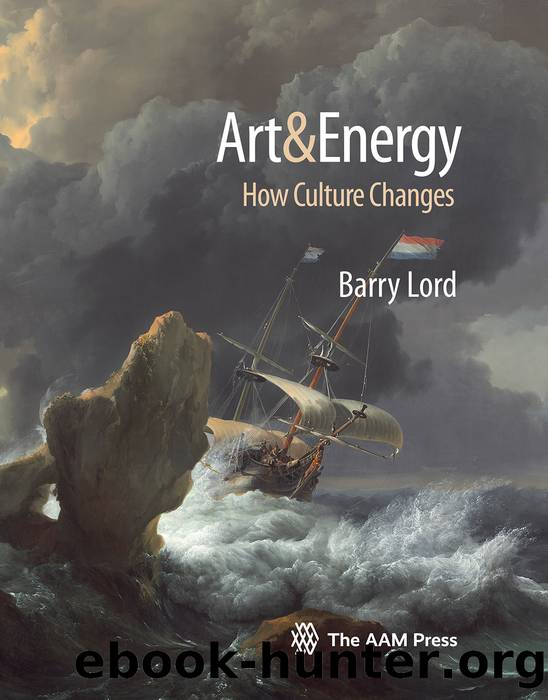Art & Energy by Barry Lord

Author:Barry Lord
Language: eng
Format: epub
ISBN: 9781933253947
Publisher: American Alliance Of Museums
Masts for the Navy, and American Exceptionalism
Masts and other timber for the navy were a royal priority in many European countries. Each monarch of the maritime empires had to defend the countryâs commerce with tall wooden sailing ships. Rafts were assembled to float tall timber from the dense forests down to the shipbuilding ports. Each nation jealously guarded its sources of tall mast timber, as well as the huge volume of wood needed for the hulls, decks and cabins of commercial fleets as well as royal navies. The scarcity of wood appropriate for shipbuilding became a political issue as early as the 15th century in Venice (Lane, 1992).
When deforestation made such tall timber scarce in England, the British turned first to Russia and the Baltic, then increasingly to their American colonies. In 1729 Whitehall imposed a law on the New England colonies, requiring that all tall pines (and saplings that might grow into them) had to be reserved for the Crown. Resistance to this law culminated in the Pine Tree Riot of 1772 in New Hampshireâa precursor of the American Revolution, although not as well known as the Boston Tea Party.
A theory often discussed among American historians and politicians is the doctrine of âAmerican exceptionalismââthe ways in which the United States claimed, and indeed still claims, an exception to the social, political or economic norms of Europe and the rest of the world. Whether or not such a theory can be justified, it was certainly true of colonial America in the age of wood and charcoal as a prime energy source. Even when they were limited to the heavily forested eastern seaboard, colonial Americansâ forest resources were so ample for their relatively small population that they had no reason to fear deforestation. As the frontier later moved westward, they could afford to be even less concerned. The American Revolution was motivated not by any concern with deforestation, but by an awareness that British imperial policy restrained full use of the vast energy resources at Americansâ disposal.2
After the American victory, the British began to get more shipâs timber from Quebec and New Brunswick. When Napoleon temporarily cut off Britainâs access to Russia and the Baltic, it was to the benefit of the eastern provinces of Canada. By 1825 Quebec City had become âthe greatest timber port the world had ever knownâ (Latham, 1957), as the great rafts floated down the Ottawa, Saguenay and St. Lawrence Rivers to serve His Majestyâs warships. British ships with sails rigged on masts made of single tall conifers had an advantage over the French, who too often had to settle for the compromise of masts made of two or more logs cobbled together (Bamford, 1956).
Download
This site does not store any files on its server. We only index and link to content provided by other sites. Please contact the content providers to delete copyright contents if any and email us, we'll remove relevant links or contents immediately.
Life 3.0: Being Human in the Age of Artificial Intelligence by Tegmark Max(5476)
The Sports Rules Book by Human Kinetics(4296)
The Age of Surveillance Capitalism by Shoshana Zuboff(4214)
ACT Math For Dummies by Zegarelli Mark(3996)
Unlabel: Selling You Without Selling Out by Marc Ecko(3591)
Blood, Sweat, and Pixels by Jason Schreier(3566)
Hidden Persuasion: 33 psychological influence techniques in advertising by Marc Andrews & Matthijs van Leeuwen & Rick van Baaren(3474)
The Pixar Touch by David A. Price(3366)
Bad Pharma by Ben Goldacre(3357)
Urban Outlaw by Magnus Walker(3342)
Project Animal Farm: An Accidental Journey into the Secret World of Farming and the Truth About Our Food by Sonia Faruqi(3178)
Kitchen confidential by Anthony Bourdain(3012)
Brotopia by Emily Chang(3001)
Slugfest by Reed Tucker(2942)
The Content Trap by Bharat Anand(2863)
The Airbnb Story by Leigh Gallagher(2800)
Coffee for One by KJ Fallon(2567)
Smuggler's Cove: Exotic Cocktails, Rum, and the Cult of Tiki by Martin Cate & Rebecca Cate(2473)
Beer is proof God loves us by Charles W. Bamforth(2374)
